
The Wankel engine is a type of internal combustion engine using an eccentric rotary design to convert pressure into rotating motion. The concept was proven by German engineer Felix Wankel, followed by a commercially feasible engine designed by German engineer Hanns-Dieter Paschke. The Wankel engine's rotor, which creates the turning motion, is similar in shape to a Reuleaux triangle, with the sides having less curvature. The rotor spins inside a figure-eight-like epitrochoidal housing around a fixed-toothed gearing. The midpoint of the rotor moves in a circle around the output shaft, rotating the shaft via a cam.
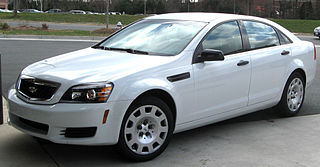
The Chevrolet Caprice is a full-size car produced by Chevrolet in North America for the 1965 to 1996 model years. Full-size Chevrolet sales peaked in 1965 with over a million sold. It was the most popular car in the U.S. in the 1960s and early 1970s, which, during its lifetime, included the Biscayne, Bel Air, and Impala.

The General Motors LS-based small-block engines are a family of V8 and V6 engines designed and manufactured by American automotive company General Motors. First introduced in 1997, the family is a continuation of the earlier first- and second-generation Chevrolet small-block engine, of which over 100 million have been produced altogether, and is also considered to be one of the most popular V8 engines ever. Spanning three generations, a new, sixth generation is expected to enter production soon. Various small-block V8s were and still are available as crate engines.
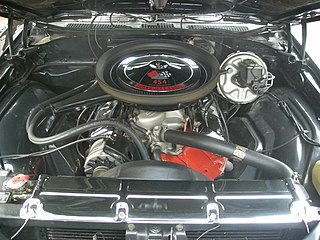
The Chevrolet "big-block" engine is a term for a series of large-displacement, naturally-aspirated, 90°, overhead valve, gasoline-powered, V8 engines; that were developed and produced by the Chevrolet Division of General Motors, from the 1950s until present.

The Chevrolet small-block engine is a series of gasoline-powered V8 automobile engines, produced by the Chevrolet division of General Motors between 1954 and 2003, using the same basic engine block. Referred to as a "small-block" for its size relative to the physically much larger Chevrolet big-block engines, the small-block family spanned from 262 cu in (4.3 L) to 400 cu in (6.6 L) in displacement. Engineer Ed Cole is credited with leading the design for this engine. The engine block and cylinder heads were cast at Saginaw Metal Casting Operations in Saginaw, Michigan.

The Chevrolet Vega is a subcompact automobile that was manufactured and marketed by GM's Chevrolet division from 1970 to 1977. Available in two-door hatchback, notchback, wagon, and sedan delivery body styles, all models were powered by an inline four-cylinder engine designed specifically for the Vega, with a lightweight, aluminum alloy cylinder block. The Vega first went on sale in Chevrolet dealerships on September 10, 1970. Variants included the Cosworth Vega, a short-lived limited-production performance model, introduced in the spring of 1975.

The Chevrolet Monza is a subcompact automobile produced by Chevrolet for the 1975 through 1980 model years. The Monza is based on the Chevrolet Vega, sharing its wheelbase, width, and standard inline-four engine. The car was designed to accommodate the GM-Wankel rotary engine, but due to mediocre fuel economy and emissions-compliance issues the engine was cancelled, and a V8 engine option was substituted. The Monza name has also been used for several other cars.

The Pontiac V8 engine is a family of overhead valve 90° V8 engines manufactured by the Pontiac Division of General Motors Corporation between 1955 and 1981. The engines feature a cast-iron block and head and two valves per cylinder. Engine block and cylinder heads were cast at Saginaw Metal Casting Operations then assembled at Tonawanda Engine before delivery to Pontiac Assembly for installation.

The Buick V6 is an OHV V6 engine developed by the Buick division of General Motors and first introduced in 1962. The engine was originally 198 cu in (3.2 L) and was marketed as the Fireball engine. GM continued to develop and refine the 3.8 L (230 cu in) V6, eventually and commonly referred to simply as the 3800, through numerous iterations.
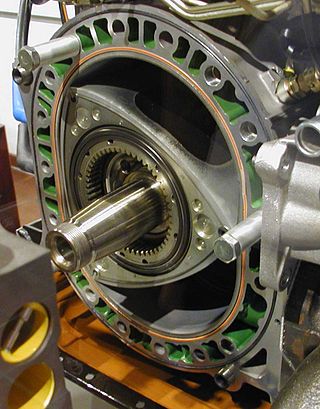
The Mazda Wankel engines are a family of Wankel rotary combustion car engines produced by Mazda.

Mazda has a long history of building its own diesel engines, with the exception of a few units that were built under license.

Power Stroke, also known as Powerstroke or PowerStroke, is the name used by a family of diesel engines for trucks produced by Ford Motor Company and Navistar International for Ford products since 1994. Along with its use in the Ford F-Series, applications include the Ford E-Series, Ford Excursion, and Ford LCF commercial truck. The name was also used for a diesel engine used in South American production of the Ford Ranger.
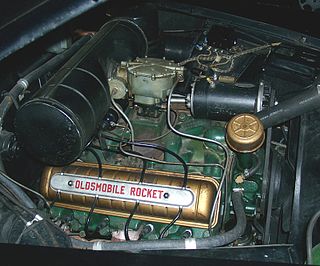
The Oldsmobile V8, also referred to as the Rocket, is a series of engines that was produced by Oldsmobile from 1949 until 1990. The Rocket, along with the 1949 Cadillac V8, were the first post-war OHV crossflow cylinder head V8 engines produced by General Motors. Like all other GM divisions, Olds continued building its own V8 engine family for decades, adopting the corporate Chevrolet 350 small-block and Cadillac Northstar engine only in the 1990s. All Oldsmobile V8s were assembled at plants in Lansing, Michigan while the engine block and cylinder heads were cast at Saginaw Metal Casting Operations.

The Buick V8 is a family of V8 engines produced by the Buick division of General Motors (GM) between 1953 and 1981. All were naturally aspirated OHV pushrod engines.
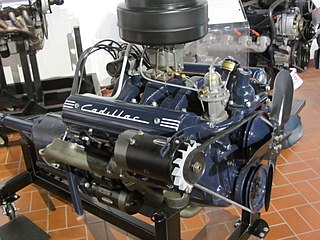
The term Cadillac V8 may refer to any of a number of V8 engines produced by the Cadillac Division of General Motors since it pioneered the first such mass-produced engine in 1914.

The Hummer H3 is an off-road vehicle that was produced from 2005 to 2010 by General Motors. The smallest model of the Hummer lineup, it was offered as a 5-door SUV or a 4-door pickup truck known as the H3T. Unlike the larger H1 and H2 models, the H3 was not developed by AM General. It was introduced for the 2006 model year, based on a modified GMT355 that underpinned the Chevrolet Colorado/GMC Canyon compact pickup trucks that were also built at GM's Shreveport Operations in Shreveport, Louisiana and the Port Elizabeth plant in South Africa. While mechanically related to the Colorado and Canyon, GM claims they share only 10% of their components, with the chassis modified and reinforced for heavy off-road duties.

The General Motors–Detroit Diesel V8 engine is a series of diesel V8 engines first introduced by General Motors for their C/K pickup trucks in 1982. Developed in collaboration with GM subsidiary Detroit Diesel, the engine family was produced by GM through 2002, when it was replaced by the new Duramax line. AM General's subsidiary General Engine Products (GEP) still produces a military variant of this engine for the HMMWV.

The Chevrolet Aerovette was a concept car created by Chevrolet, beginning life as Experimental Project 882 (XP-882) in the late 1960s. It had a mid-engine configuration using a transverse mounting of its V8 engine. Zora Arkus-Duntov's engineers originally built two XP-882 prototypes during 1969, but John DeLorean, Chevrolet's general manager, canceled the program believing it to be impractical and costly. However, when Ford announced plans to sell the DeTomaso Pantera through Lincoln-Mercury dealers, DeLorean ordered that one XP-882 prototype be cleaned up for display at the 1970 New York Auto Show.

The Chevrolet Cosworth Vega is a subcompact four-passenger automobile produced by Chevrolet for the 1975 and 1976 model years. It is a limited-production version of the Chevrolet Vega, with higher performance.
The MidWest AE series are lightweight, liquid-cooled, single- and twin-rotor Wankel engines, with dual ignition, designed for light aircraft. They were produced by Mid-West Engines Ltd. at Staverton Airport, Gloucestershire, UK.






















